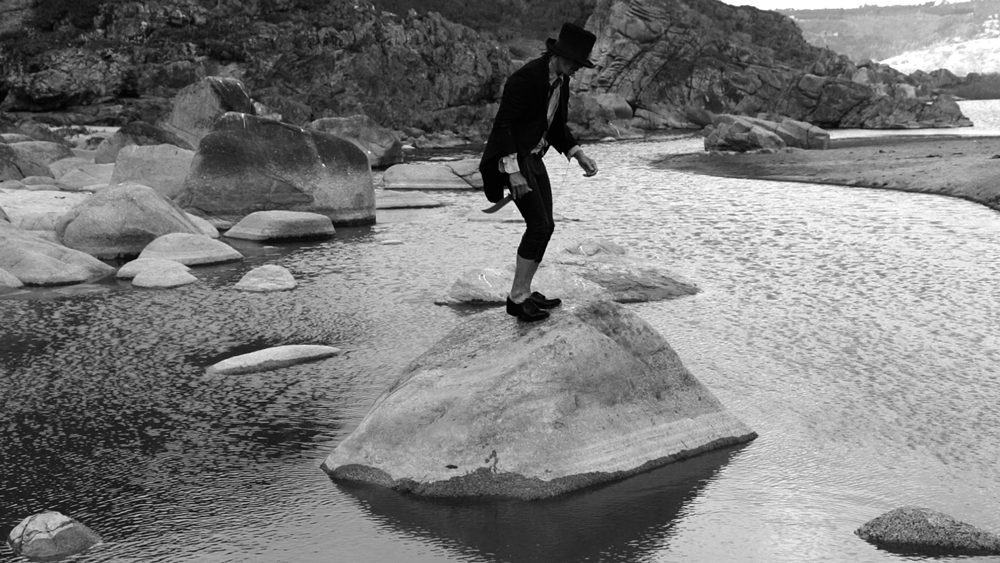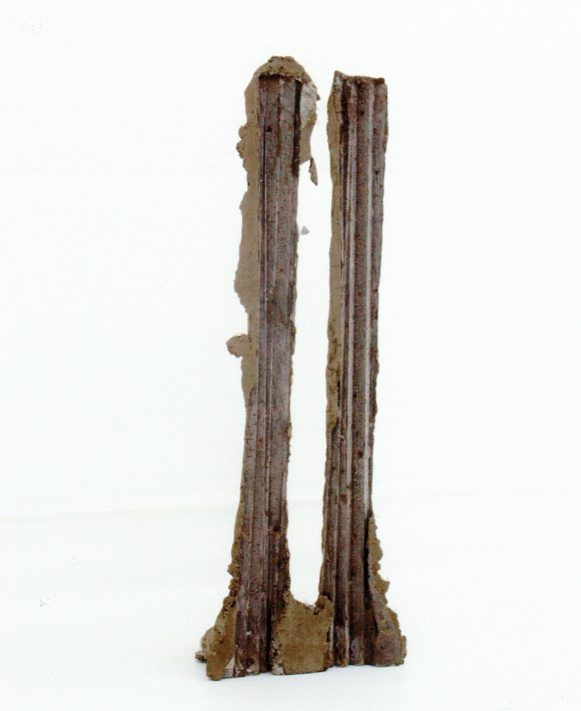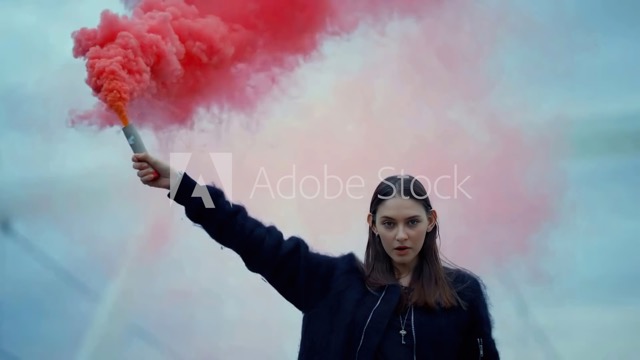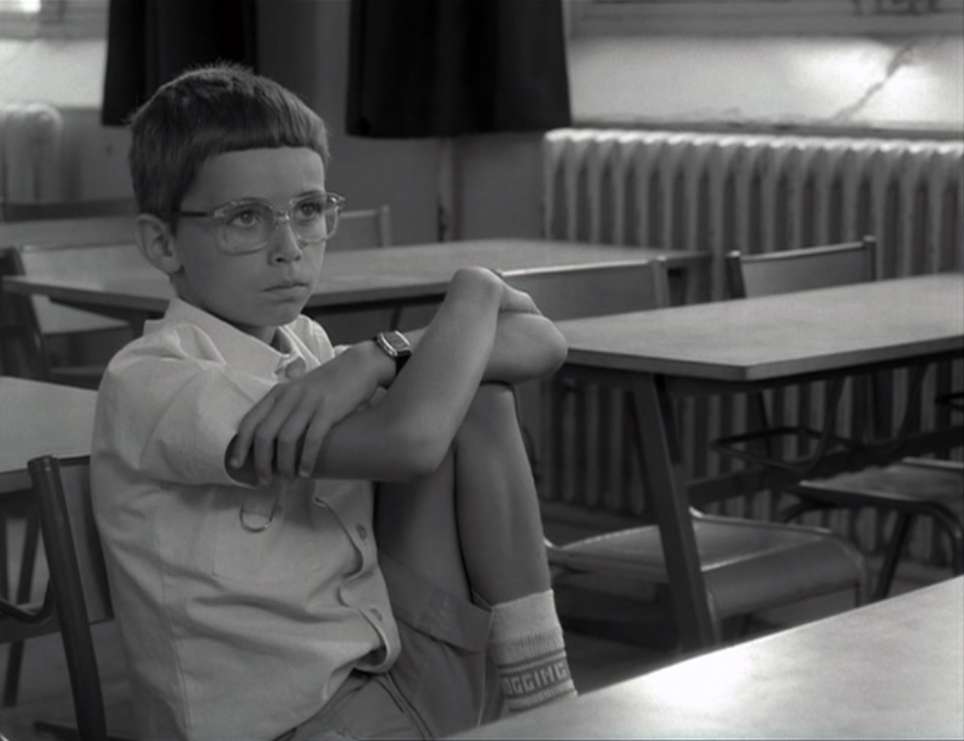
© » KADIST
Jean-Charles de Quillacq
Adam is an emblematic work within Jean-Charles de Quillacq’s oeuvre. The artist has created a number of pieces entitled Adam , referring to original man, incarnated in multiple objects at once. Materially, Adam is a fluorescent yellow walking rope with an epoxy coating on one side, rendering the structure rigid, demonstrative of his sculptural practice which is both conceptual and sensual.

© » KADIST
Juan Carlos Alom
In Amantes (Lovers) Juan Carlos points his lens at his own environment, his underground (literally) studio in Havana. A beautiful and intimate image of a seedy yet casual scene of two lovers in the background foreshadowed by a beautiful young woman smoking a joint in the foreground, a very powerful and not too subtle political representation of the current realities and truth of youth life in Havana. Juan Carlos Alom is an artist known for his documentary photography of Cuba’s subcultures and underground scenes.

© » KADIST
Charles Gaines
To make his series Shadows (1980), Gaines subjected 20 potted plants to a uniform procedure. Each is pictured four times: a photograph of the plant, a photograph of its shadow, a drawing of the plant, and a drawing of its shadow. Instead of lending structure to disparate entities, this system serves a counterintuitive purpose, dissolving the object.

© » KADIST
Charles Avery
Drawing & Print (Drawing & Print)
Charles Avery has been constructing a narrative in his work since 2004. Between fantasy and reality, The Islanders is a very particular universe he has created in which to gather his disparate ideas. His practice primarily involves drawing, sculptures, texts and installations which participate in the epic and dreamlike narrative whole in the course of making.

© » KADIST
Jean Claracq
View From an Apartment features 18-year-old Joland Novaj whose image was taken from Instagram. Staring vacantly at his cereal bowl, his computer is open on his own Instagram account and Steinbeck’s “Grapes of Wrath” lies open next to it, illustrated with a XV century illumination. Beyond the room there is a bay, lined with modernist buildings.

© » KADIST
Charles Avery
Drawing & Print (Drawing & Print)
Since 2005, Charles Avery has devoted his practice to the perpetual description of a fictional island. Replete with its own population and constantly shifting topography, Avery’s intricately conceived project amounts to an ever-expanding body of drawings, sculptures, installations and texts which evince the island. Exhibited incrementally these heterogeneous elements serve as terms within the unifying structure of the island – as multiple emissions of an imaginary state, and as a meditation on the central themes of philosophy and the problems of art-making.

© » KADIST
Charles Lim
In SEA STATE 6 Charles Lim takes the viewer down the Jurong Rock Caverns in Singapore, a massive underground infrastructure for oil and fuel storage, built to support the commercial operations of oil traders, petrochemical ventures and manufacturing industries in the area. The first of its kind in Southeast Asia. Located at a depth of 130 meters beneath the Banyan Basin on Jurong Island, the Caverns provide infrastructural support to the petrochemical industry that operates on Singapore’s Jurong Island, a cluster of islets reclaimed into one major island and connected to the mainland in the 1980s.

© » KADIST
Charles Lim
In SEA STATE 6 Charles Lim takes the viewer down the Jurong Rock Caverns in Singapore, a massive underground infrastructure for oil and fuel storage, built to support the commercial operations of oil traders, petrochemical ventures and manufacturing industries in the area. The first of its kind in Southeast Asia. Located at a depth of 130 meters beneath the Banyan Basin on Jurong Island, the Caverns provide infrastructural support to the petrochemical industry that operates on Singapore’s Jurong Island, a cluster of islets reclaimed into one major island and connected to the mainland in the 1980s.

© » KADIST
Sergio De La Torre
This is not in Spanish looks at the ways in which the Chinese population in Mexico navigates the daily marginalization they encounter there. The neon translates as “this is not in Spanish,” making reference to both the famous Rene Magritte painting “Ceci n’est pas une pipe” as well as signs posted in the windows of Chinese establishments in Mexico.

© » KADIST
Jorge de León
Jorge de León most well-known work was a radical gesture, and one of his earliest artworks: in his 2000 performance, The Circle, de León sewed his own mouth closed as a protest against the silencing of citizens in the face of social corruption. His Cristal series is more demure, but follows a similar theme. In these works, delicate, web-like lines emerge against dark backgrounds, creating orbs of negative space, pitch black.

© » KADIST
Charwei Tsai
Charwai Tsai’s photograph documents her Hermit Crab Project installation upon the construction site of gallery Sora in Tokyo. Tsai placed live hermit crabs and shells in a sandy enclosure at the site, writing fragments of The One China policy and the Taiwanese Independence statements on each shell. As the hermit crabs moved and swapped shells, they formed new connections between the statements.

© » KADIST
Lenora de Barros
Lenora de Barros’s poetics are known for setting in motion an intimate relationship between image and the written word. This was precisely one of the questions raised while producing the photographs that compose Poema , one of de Barros’s first and most iconic visual poems. The work consists of a sequence of six black and white photographs where language acts in a performative movement with the typewriter, forging a connection between word and image.

© » KADIST
Sergio De La Torre
Nuevo Dragon City is a reenactment of a historical event from 1927 in which six Chinese were either trapped or voluntarily hid themselves inside a building in northern Mexico. Working with this unsettled mystery, De La Torre’s video inquires into the historical and continuing tensions between Chinese and Mexicans. As such, Nuevo Dragon City depicts a symbolic act of self-entrapment in which six untrained actors of Chinese descent silently blockade themselves inside in an empty Tijuana storefront.

© » KADIST
Enar de Dios Rodríguez
Ecotone by Enar de Dios Rodríguez is a video work presented in six chapters, each beginning and ending with a one-sided telephone dialog with an informal, friendly and conversational tone, that leads quickly into complex philosophical subjects. The first chapter is an introduction, and the last is an epilogue, and both employ interfaces (a smartphone screen, and an optical illusion, respectively) to invite the viewer to make conceptual connections across the chapters. An “ecotone” is a region of transition between two biological communities.

© » KADIST
Jean-Luc Moulène
Drawing & Print (Drawing & Print)
On a piece of paper, the artist has traced two loops in black crayon and placed two eyes where the lines intersect. Cut out of the same photograph, the eyes belong to the same gaze. The first asset of a slip knot is its simplicity, it basically requires a small length of rope.

© » KADIST
Marlon de Azambuja
Following a series of related works, Brutalismo Americano by Marlon de Azambuja is a site-specific sculptural installation produced during the artist’s residency at Kadist, San Francisco in 2017. Treating the city as an object of attention, de Azambuja collected building materials from the surrounding area over a period of ten days to conceive of an architecture in situ. The work is not meant to mimic any of San Francisco’s own architecture, or to be a maquette or portrait of the cityscape, but instead a singular, constructive gesture.

© » KADIST
Jean-Luc Moulène
Head Box by J ean-Luc Moulène i s not the representation of a space but a real space that remains in the domain of sculpture which the artist develops in parallel with his photographic practice. Created for an exhibition in Kitakyushu in Japan, it is painted green, a color that symbolizes life and creation in Japanese culture. Even though we are confronted with a hollow presence, this is above all a space to lodge a body in the vertical posture of the living.

© » KADIST
Caetano de Almeida
Caetano de Almeida’s abstract compositions in acrylic use delicately-rendered swirls of overlapping, colorful lines. Intersecting at regular angles within six bubbles, these thread-like lines spiral chaotically outward once they leave these spheres of order. De Almeida’s abstractions don’t imply randomness and chaos, the way much abstract painting might, but rather seem tied to algorithms, precision, and the networked realities of the contemporary moment.

© » KADIST
Jean-Luc Moulène
It rains, Paris, 1st July 2000 , which could be the refrain of a song, is the title of a photograph of a minimal moment, the vision of a Parisian pedestrian, a cut flower lying on the pavement covered in rain drops. Is this moment captured by chance or a mise en scène? There is a sort of hiatus in the image; the planes – motif and background – connect nature in full bloom, pure, fragile, ephemeral with the grey weighty tarmac.

© » KADIST
Carlos Garaicoa
From the series the Old and the New (XI) by Carlos Garaicoa belongs to the series Lo viejo y lo nuevo / Das Alte und das Neue (The Old and the New) which was first exhibited in 2010 at Barbara Gross Gallery in Germany. Here, Garaicoa’s interest in vernacular Cuban architecture shifts towards the European context: a series of twelve nineteenth-century French engravings have been reworked into delicate paper models. Here, the two-dimensional old-school architectural renderings have become the foundation for new hollow three-dimensional structures.

© » KADIST
Gabriel Chaile
For the project Aguas calientes Gabriel Chaile exchanged silverware from three popular soup kitchens (mutual aid organizations to provide food for people in need) in Buenos Aires to brand new cooking utensils to shape his project. Chaile then reworks the used goods, welding and engraving the names of their sites of provenance and imagery from local indigenous community’s visual repertoire; faces from vessels and iconography present in Cultura Tafí, Condorhuasi, Alamito, Santa María, Candelaria, and Ciénaga. Through this operation, he translates the idea of the “communal pot” into a meeting point for mutual cooperation and political resistance.

© » KADIST
Carlos Amorales
This work, a large oil painting on canvas, shows a moment from Amorales’s eight-minute two-channel video projection Useless Wonder (2006). The video is based on Edgar Allen Poe’s 1838 novel The Narrative of Arthur Gordon Pym of Nantucket . The painting, derived from an image from a different, preexisting work, represents the artist’s continued interest in realizing particular subject matter in alternative forms, thereby imbuing it with new meanings and interpretations.

© » KADIST
Juan Araujo
Residencia Milan 1 is a painting of a house surrounded by lush forest. The image depicted is both photorealistic and creates the illusion of an unfolded piece of paper, with creases and discolorations. In referring to the circulation of images, the painting raises questions of a viewer’s relationship to the image of a beautiful house: as icon, wish, or standard of beauty.

© » KADIST
Juan Capistran
White Minority , is typical of Capistran’s sampling of high art genres and living subcultures in which the artist subsumes an object’s high art pedigree within a vernacular art form. Here, Capistran humorously remixes the form and style of Frank Stella’s Black Paintings with California punk rock band Black Flag’s song title and logo (created by artist Raymond Pettibon). White Minority , then, appropriates, recontextualizes, and riffs on language and visual signs to unmoor notions of identity, power, and revolution.

© » KADIST
Juan Capistran
The 10 $1 bills that make up From a Whisper to a Scream (2012) read like instructions in origami. From left to right, each bill is progressively folded up, step by step, into the shape of a gun. Both a scream and a whisper are capable of conveying the same content, if at drastically different decibels, the artist proposes.

© » KADIST
Juan Brenner
The photographic series Tonatiuh (The Son of the Sun) by Juan Brenner is an in-depth visual study of current Guatemalan society from the perspective of miscegenation and the incalculable consequences of the Spanish conquest. Establishing Spanish conquistador Pedro de Alvarado as a central figure, not only in the conquest of Guatemala, but also in the formation of a complex, segregated society, Brenner proposes a series of images that re-establish the lens through which to consider both a historical and contemporary Guatemala. Tonatiuh is a visual essay on the state of a country on the verge of failure and its incapacity to address its own history and learn from it.
Carlos Amorales
- year born: 1970
- gender: male
- nationality: Mexican
- home town: Mexico City, Mexico
Danielle Dean
Danielle Dean creates videos that use appropriated language from archives of advertisements, political speeches, newscasts, and pop culture to create dialogues to investigate capitalism, post-colonialism, and patriarchy...
Juan Araujo
- year born: 1971
- gender: male
- nationality: Spanish
- home town: Caracas, Venezuela
Juan Capistran
- location: Los Angeles, California
- gender: male
- nationality: Mexican American
- home town: Guadalajara, Mexico
Chen Chieh-Jen
- location: Taipei, Taiwan
- year born: 1960
- gender: male
- nationality: Chinese
- home town: Taoyuan, Taiwan
Charles Lim
Charles Lim Yi Yong’s work encompasses film, installation, sound, recorded conversations, text, drawing, and photography...
Sergio De La Torre
Sergio De La Torre has worked with and documented the manifold ways in which citizens reinvent themselves in the city they inhabit, as well as the site-specific strategies they deploy to move “in and out modernity.” De La Torre often collaborates with his subjects, resulting in both intimate and critical reflections on topics like housing, immigration, and labor...
Charles Avery
- location: Oban, United Kingdom
- year born: 1973
- gender: male
- nationality: British
Gabriel Chaile
Gabriel Chaile’s work draws on references ranging from Pre-Columbian cultures to Conceptualism in often-usable sculptures involving bricks, adobe structures, and other found objects...
Jean-Charles de Quillacq
Artist Jean-Charles de Quillacq erects works which have a complicated relationship to remaining upright...
Charles Gaines
- location: Los Angeles, California
- year born: 1944
- gender: male
- nationality: American
- home town: Charleston, South Carolina
Carlos Motta
Carlos Motta’s is a multi-disciplinary artist whose work seeks to document the social conditions and political struggles of sexual, gender, and ethnic minority communities through a variety of variety of mediums including video, installation, sculpture, drawing, web-based projects, performance, and symposia...
Lenora de Barros
Lenora de Barros studied linguistics and started her artistic career in the 1970s...
Aria Dean
Through art, text, and exhibition making, Aria Dean analyzes the structure and circulation of images and subjectivities in relation to material, cultural histories, and technology...
Christina Quarles
Christina Quarles’ work is concerned with the female body...
davi de jesus do nascimento
davi de jesus do nascimento grew up in Pirapora, a town in the north of Minas Gerais, which guides the narratives of his work, as does the heritage of his family of fishermen, laundresses, and Carranca masters...
Jean Claracq
Jean Claracq uses his work to deal with issues of loneliness in the social media era, depicting scenes of everyday life featuring isolated individuals against broad infrastructures as an evocation of alienation...
Marlon de Azambuja
Based on ideas of architecture, and by means of appropriation of public space and studio-based material operations, Marlon de Azambuja’s work creates new idioms for thinking and inhabiting the built environment...
Juan Covelli
Juan Covelli uses technology as a medium;, striving to decolonize the museum through digital practices, he releases archives from institutional control for the sake of emancipation...
Michael Dean
Michael Dean (b...
Juan Brenner
Born and raised in Guatemala, photographer Juan Brenner spent ten years in New York City working in the fashion industry before returning to his home country in 2008...
Tacita Dean
- location: Berlin, Germany
- year born: 1965
- gender: female
- nationality: British
- home town: Canterbury, United Kingdom
Sergio Rojas Chaves
Sergio Rojas Chaves’s work focuses on contemporary depictions of animals and of plants and affective approaches to biology...
Charwei Tsai
- location: Taipei, Taiwan
- location: Paris, France
- year born: 1980
- gender: female
- nationality: Taiwanese
- home town: Taipei, Taiwan
Raimond Chaves and Mantilla Gilda
The collaborative works of Raimond Chaves and Mantilla Gilda often derive from a direct engagement with the world...
Carlos Garaicoa
- location: Madrid, Spain
- year born: 1967
- gender: male
- nationality: Cuban
- home town: Havana, Cuba
Juan Obando
As a Colombian who studied and now lives in Arizona, Juan Obando has a non-native perspective on the media-obsessed culture of the US...
-
1980-1989
Charles Gaines
1980To make his series Shadows (1980), Gaines subjected 20 potted plants to a uniform procedure...
Jean-Marie Straub and Danièle Huillet
1982En rachâchant is based on the short story Ah! Ernesto! (1971) by Marguerite Duras in which the child Ernesto does not want to go to school anymore as all that he is taught are things he does not know...
-
1990-1999
Jean-Luc Moulène
Drawing & Print
1997(Drawing & Print) On a piece of paper, the artist has traced two loops in black crayon and placed two eyes where the lines intersect...
-
2000-2009
Tacita Dean
2001The photographic quality of the film Baobab is not only the result of a highly sophisticated use of black and white and light, but also of the way in which each tree is characterized as an individual, creating in the end a series of portraits...
Juan Capistran
2002The Breaks reflects Capistran’s interests in sampling and fusing different cultural, social, and historical sources...
Jean-Luc Moulène
2004It rains, Paris, 1st July 2000 , which could be the refrain of a song, is the title of a photograph of a minimal moment, the vision of a Parisian pedestrian, a cut flower lying on the pavement covered in rain drops...
Juan Capistran
2005White Minority , is typical of Capistran’s sampling of high art genres and living subcultures in which the artist subsumes an object’s high art pedigree within a vernacular art form...
Carlos Amorales
Drawing & Print
2005(Drawing & Print) Produced on the occasion of an exhibition at ARTIUM of Alava, Basque Centre-Museum of Contemporary Art, this deck of cards is a selection of images from Carlos Amorales’s Liquid Archive...
Carlos Amorales
2006This work, a large oil painting on canvas, shows a moment from Amorales’s eight-minute two-channel video projection Useless Wonder (2006)...
Juan Araujo
Drawing & Print
2006(Drawing & Print) Many of Araujo’s works depict reproductions and Libro Ponti II is a recreation of a book on Italian architect Gio Ponti...
Carlos Amorales
2007This work, a large oil painting on canvas, shows a moment from Amorales’s eight-minute two-channel video projection Useless Wonder (2006)...
Charwei Tsai
2008Charwai Tsai’s photograph documents her Hermit Crab Project installation upon the construction site of gallery Sora in Tokyo...
Sergio De La Torre
2008Nuevo Dragon City is a reenactment of a historical event from 1927 in which six Chinese were either trapped or voluntarily hid themselves inside a building in northern Mexico...
Jean-Luc Moulène
2009Head Box by J ean-Luc Moulène i s not the representation of a space but a real space that remains in the domain of sculpture which the artist develops in parallel with his photographic practice...
-
2010-2019
Carlos Garaicoa
2010From the series the Old and the New (XI) by Carlos Garaicoa belongs to the series Lo viejo y lo nuevo / Das Alte und das Neue (The Old and the New) which was first exhibited in 2010 at Barbara Gross Gallery in Germany...
Chen Chieh-Jen
2010Empire’s Borders II – Passage and Empire’s Borders II – Workers are from the three-channel film installation Empire’s Borders II – Western Enterprise, Inc...
Chen Chieh-Jen
2010Empire’s Borders II – Passage and Empire’s Borders II – Workers are from the three-channel film installation Empire’s Borders II – Western Enterprise, Inc...
Charles Avery
Drawing & Print
2011(Drawing & Print) Charles Avery has been constructing a narrative in his work since 2004...
Sergio De La Torre
2011This is not in Spanish looks at the ways in which the Chinese population in Mexico navigates the daily marginalization they encounter there...
Juan Carlos Alom
2012In Amantes (Lovers) Juan Carlos points his lens at his own environment, his underground (literally) studio in Havana...
Charles Avery
Drawing & Print
2012(Drawing & Print) Since 2005, Charles Avery has devoted his practice to the perpetual description of a fictional island...
Juan Capistran
2012The 10 $1 bills that make up From a Whisper to a Scream (2012) read like instructions in origami...
Danielle Dean
2012No Lye by Danielle Dean documents a group of five women, including Dean herself, confined to a small, cramped bathroom, communicating only by using slogans culled from beauty advertisements (“beauty is skin deep”, “naturalise, it’s in our nature to be strong and balanced”) and quotes from political speeches (“we must protect our borders”, “we are fighting for our way of life and our ability to fight for freedom”)...
Jean-Charles de Quillacq
2013Adam is an emblematic work within Jean-Charles de Quillacq’s oeuvre...
Caetano de Almeida
2013Caetano de Almeida’s abstract compositions in acrylic use delicately-rendered swirls of overlapping, colorful lines...
Charles Lim
2014In SEA STATE 6 Charles Lim takes the viewer down the Jurong Rock Caverns in Singapore, a massive underground infrastructure for oil and fuel storage, built to support the commercial operations of oil traders, petrochemical ventures and manufacturing industries in the area...
Charles Lim
2014In SEA STATE 6 Charles Lim takes the viewer down the Jurong Rock Caverns in Singapore, a massive underground infrastructure for oil and fuel storage, built to support the commercial operations of oil traders, petrochemical ventures and manufacturing industries in the area...
Carlos Amorales
2014Carlos Amorales, based in Mexico City, works in many media and combinations thereof, including video, drawing, painting, photography, installation, animation, and performance...
Carlos Fernández
2014Part of the exhibition PIÑA MATRIZ (2014) at Despacio Art, this untitled work by Carlos Fernández is a wood panel (formerly a section of a wooden table top) that bears the residue of insects interacting with fermented pineapple...
Carlos Motta
2014Searching for We’wha is composed of five photographic triptychs combining photographs from the American West (New Mexico and Arizona) with excerpts from American Indian poetry in an attempt to reconstruct imaginary aspects of the life of We’Wha, a famous member of the Zuni tribe, who was born male but who lived a feminine gender expression...
Jorge de León
2015Jorge de León most well-known work was a radical gesture, and one of his earliest artworks: in his 2000 performance, The Circle, de León sewed his own mouth closed as a protest against the silencing of citizens in the face of social corruption...
Danielle Dean
2015Hexafluorosilicic acid is a type of sodium fluoride waste product that can be found in a large amount of widely available products such as cleaning fluids, toothpaste, rat poison, and drinking water...
Danielle Dean
2016In 2003, Nike released a pair of red and black sneakers (the Dunk Low Pro SB ) that were marketed as “vampire” sneakers...
Bárbara Wagner & Benjamin de Burca
2016Originally commissioned for the 32nd Sao Paulo Biennial, the film Estás vendo coisas (You are seeing things) depicts the subculture of Brega music, a fusion of American Hip Hop, Brazilian techno and Caribbean reggaeton that emerged in North Eastern Brazil over the last decade...
Jean Claracq
2017View From an Apartment features 18-year-old Joland Novaj whose image was taken from Instagram...
Marlon de Azambuja
2017Following a series of related works, Brutalismo Americano by Marlon de Azambuja is a site-specific sculptural installation produced during the artist’s residency at Kadist, San Francisco in 2017...
Danielle Dean
2017In True Red Ruin (Elmina Castle) , Danielle Dean uses archival documents to re-imagine colonial history from the 1400s, while also referencing her own personal history...
Juan Brenner
2018The photographic series Tonatiuh (The Son of the Sun) by Juan Brenner is an in-depth visual study of current Guatemalan society from the perspective of miscegenation and the incalculable consequences of the Spanish conquest...
Christina Quarles
2018The title of the painting refers to the fact that the figure’s behind is raised upwards and the face is found at the bottom of the painting, thus inverting the way in which people are normally seen...
Sergio Rojas Chaves
2018Más vale pájaro en mano que cien volando (A bird in the hand is worth more than two in the bush) is part of a larger series of pieces developed by Sergio Rojas Chaves in Honduras in 2018 that engages with tourism and in particular amateur-ornithologists that overrun the country in pursuit of the nation’s extreme diversity of bird species...
Gabriel Chaile
2019For the project Aguas calientes Gabriel Chaile exchanged silverware from three popular soup kitchens (mutual aid organizations to provide food for people in need) in Buenos Aires to brand new cooking utensils to shape his project...
-
2020-2029
Lenora de Barros
2021Lenora de Barros’s poetics are known for setting in motion an intimate relationship between image and the written word...
Juan Covelli
2021El Salto (The Jump/The Waterfall) by Juan Covelli depicts the Salto de Tequendama, a waterfall located on the outskirts of southwest Bogota...
Enar de Dios Rodríguez
2022Ecotone by Enar de Dios Rodríguez is a video work presented in six chapters, each beginning and ending with a one-sided telephone dialog with an informal, friendly and conversational tone, that leads quickly into complex philosophical subjects...
davi de jesus do nascimento
Drawing & Print
2022(Drawing & Print) davi de jesus do nascimento’s earthy paintings, from the series sorvedouro , recall his memories as an essentially organic matter...
Miguel and Natalia Fernández de Castro and Mendoza
2022The Absolute Restoration of All Things is a collaboration by artist Miguel Fernández de Castro and anthropologist Natalia Mendoza...
Juan Obando
2023They/Them by Juan Obando is a video essay and deepfake that uses Adobe Stock clips, maintaining their branded watermark, but animating the scenes underneath with a narrative of self-critical awareness...





























